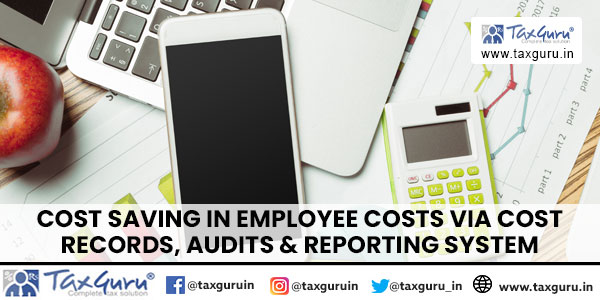Cost Saving Ideas in Employee Cost through Cost Records, Cost Audit and Cost Reporting System
Summary: Employee costs can vary significantly across industries, with labor-intensive sectors like textiles and footwear bearing higher costs, often ranging from 5% to 50% of sales. The systematic use of Cost Records, Cost Audits, and analytical reports can help reduce employee costs. Cost records categorize employee expenses by department or function, providing a clear picture of costs across production, utility, service, administration, and distribution departments. Reports such as cost center-wise employee costs, process-wise direct employee costs, and wages and man-hours analysis enable detailed monitoring of labor costs and identification of inefficiencies like overtime or idle time. These tools allow management to make informed decisions, leading to cost savings and better resource management. While reducing employee costs is crucial, management should also focus on maintaining a motivated and trained workforce. Optimizing employee costs requires a balance between cost-saving strategies and maintaining employee morale and efficiency.
Employee cost varies from industry to industry. In case of labour intensive sectors like Textiles, Footwear, Plastics and others it is high. Generally, it ranges from 5% to 15% of sale in manufacturing Industry. In Service Industry, It can be as high as 50%. Cost Records, Cost Audit and various analytical reports prepared on the basis of cost records can help in saving in employee cost. Even if company can reduce employee cost by 2-3%, in case of large turnover companies it results in huge savings.

Cost records require classification and presentation of employee cost in specific manner. Before we go to the cost saving ideas, let us understand the classification and presentation part.
Page Contents
Classification and Presentation of Employee Cost in Cost Records
CRA -1 (As per rule 5(1) of the Companies (Cost Records and Audit) Rules, 2014) and Cost Accounting standard on Employee Cost (CAS-7) lay down the principles of classification and presentation of Employee Cost. Cost centrewise employee cost is calculated. It is classified based on in which department it is incurred and function of that department. Employee cost of production departments is taken to respective production cost centre. Employee cost of Utilities centres like Power, Steam, Water treatment etc. are taken to respective utility centre. Employee cost of service cost centres like Quality Control, Maintenance Department etc. are taken to respective service centre. Employee cost related to Administration and Selling & Distribution functions are classified separately. This classification of employee cost helps in proper presentation as per rules and help in further analysis of cost.
Presentation in Product \ Service Cost Sheet
Employee cost of production centres will go as a separate item in Product Cost Sheet as Direct Employee Cost. Employee cost related to Utilities, Service centres and Overheads will flow indirectly through Utility cost and Overhead cost in Product\Service cost sheet.
Following analytical reports can help the management in monitoring and reducing employee cost.
1. Cost Centrewise Employee Cost
There are various cost centres in any company. Setting up cost centres is a first step towards cost classification. Cost Centrewise employee cost of current year and comparison with previous two years can be very helpful.
Cost Centrewise Employee Cost Report is explained below.
| Cost Centrewise Employee Cost | |||
| Cost Centre | Current Year | Previous Year 1 | Previous Year 2 |
| Production Cost Centres | |||
| PC 1 | |||
| PC 2 | |||
| Sub-Total | |||
| Utilities Cost Centres | |||
| Power | |||
| Steam | |||
| Water Treatment | |||
| Sub-Total | |||
| Other Service Centres | |||
| Maintenance | |||
| Quality Control | |||
| Sub-Total | |||
| Administration | |||
| Selling & Distribution | |||
| Grand Total | |||
Benefits of above Report
- This report at a glance shows cost centrewise employee cost of Current Year and comparison with Previous two years.
- Management can analyse the reasons for increase or decrease cost centrewise. Normal increment of salaries or wages can be one reason for increase. Abnormal increase may be due to increase in number of employees, overtime hours, process changes or wage revision agreements with trade unions etc.
2. Processwise Direct Employee Cost
Each Product or Service passes through various processes before becoming final output. Calculation of manhours for each process and calculating direct employee cost for each process is challenging but very useful. Comparison with standards, if any, can be made.
Processwise Direct Employee Cost Report is explained below.
| Processwise Direct Employee Cost | Period | ||||
| Name of Process | Manhours | Rate | Employee Cost | Standard Cost | Variance |
| Process 1 | |||||
| Process 2 | |||||
| Total | |||||
Standards used can be of two types
- Own Standards: Company can develop its own standards based on Method & Time Study.
- External Standards: There may be standards published by various research associations e.g. for textile industry there are research organisations like ATIRA, BTRA, SITRA etc. Providing consultancy is one of the activities of these organisations. Norms of these organisations should be reworked as per the prevailing work conditions of own company.
Benefits of above report
- This report gives direct employee cost of each process \ operation and helps in cost monitoring at micro level.
- This report helps in analysing reasons of increase in process cost and in taking remedial action. Reasons can be numerous like improper supervision, quality of materials or tools or equipments, difficulties in operation and methods of work etc.
3. Wages and Manhours Analysis
Cost Centrewise Wages are analysed into normal wages and overtime wages. Similarly, Man days actually worked, Man days paid and overtime hours are calculated.
Wages and Manhours Analysis Report is explained below.
| Wages and Manhours Analysis | Period | |||||
| Cost Centre | Mandays worked | Mandays Paid | Wages | Overtime hours | Overtime Payment | Total Wages & O.T. |
| Production Cost Centres | ||||||
| PC 1 | ||||||
| PC 2 | ||||||
| Sub-Total | ||||||
| Utilities Cost Centres | ||||||
| Power | ||||||
| Steam | ||||||
| Water Treatment | ||||||
| Sub-Total | ||||||
| Other Service Centres | ||||||
| Maintenance | ||||||
| Quality Control | ||||||
| Sub-Total | ||||||
| Administration | ||||||
| Selling & Distribution | ||||||
| Grand Total | ||||||
Benefits of above report
- This report helps in identifying idle time and overtime. Suitable action can be taken after identification.
Conclusions
Cost Records, Cost Audit and analytical reports as given above help in monitoring of employee cost which is necessary as an overall strategy to reduce product\service cost. At the same time, management has to keep in mind that employees are assets of the company. Training and Motivation of employees are very necessary. Objective should be reduction of overtime cost wherever possible and reduction of idle time so as to achieve practical optimum direct employee cost. Employee cost can also be optimised by taking proper managerial decisions like Employing own labour vs. Contract labour, Hiring employee vs. engaging consultant and effectiveness of Production\ Performance linked incentive plans etc. Various non cost factors also need to be considered in taking managerial decisions.





